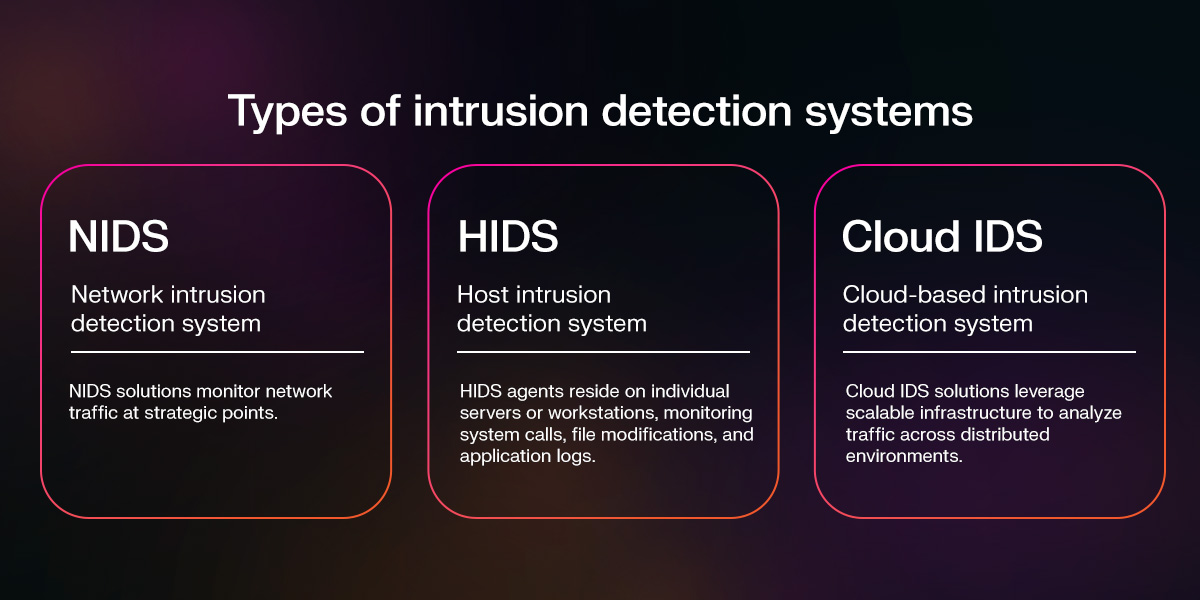What is Intrusion Detection System?
Types of intrusion detection systems
Organizations deploy various IDS architectures depending on infrastructure requirements, security objectives, and operational constraints.

Network intrusion detection system (NIDS)
NIDS solutions monitor network traffic at strategic points, typically behind firewalls or at network segment boundaries. These systems analyze packet headers and payloads to identify suspicious patterns or known attack signatures. NIDS deployment provides broad visibility but struggles with encrypted traffic and high-speed networks that can overwhelm processing capabilities.
Host intrusion detection system (HIDS)
HIDS agents reside on individual servers or workstations, monitoring system calls, file modifications, and application logs. These systems excel at detecting insider threats and identifying compromise indicators on critical assets. However, HIDS requires installation and maintenance across multiple endpoints, creating management overhead and potential performance impacts on monitored systems.
Cloud-based intrusion detection system (Cloud IDS)
Cloud IDS solutions leverage scalable infrastructure to analyze traffic across distributed environments. These systems address traditional deployment challenges by eliminating hardware requirements and providing centralized management. Cloud-based approaches particularly benefit organizations with hybrid infrastructures, though they introduce dependencies on internet connectivity and raise data sovereignty concerns for regulated industries.
What are practical alternatives to IDSs?
Despite their widespread deployment, traditional IDS solutions face critical limitations that increasingly undermine their effectiveness against modern threats:
- Inability to detect novel attacks
- Excessive false positives
- Limited visibility into encrypted traffic
- Passive response limitation
- Lack of contextual understanding
- Resource-intensive management
Today's adversaries employ advanced techniques that bypass traditional, signature-based detection methods, leveraging zero-day exploits and polymorphic malware to render conventional IDS solutions inadequate. This shift necessitates exploring advanced detection methodologies such as:
Intrusion prevention system (IPS)

IPS technology extends IDS functionality by actively blocking detected threats. These solutions provide immediate threat mitigation without human intervention, reducing the window of opportunity for attackers. IPS platforms incorporate reputation filtering, sandboxing, and SSL inspection to enhance detection accuracy.
However, false positives in IPS deployments cause service disruptions, requiring careful tuning to balance security and availability. Organizations must maintain bypass mechanisms to prevent IPS failures from causing network outages.
Security information and event management (SIEM)
SIEM platforms represent the core of many security approaches, aggregating and analyzing logs from across an organization's digital environment and applications. As such, they provide centralized visibility and correlation, with advanced analytics to identify attack patterns spanning multiple systems and time frames that individual tools miss. SIEM solutions incorporate user and entity behavior analytics (UEBA) to detect insider threats and compromised credentials and support compliance requirements through comprehensive audit trails and automated reporting.
SIEM deployments are valuable, but they require significant investment in licensing, infrastructure, and skilled personnel for effective operation.
Endpoint detection and response (EDR)
EDR solutions focus on endpoint threats, providing detailed forensics and automated containment capabilities. These tools record comprehensive endpoint telemetry, enabling retroactive threat hunting and incident investigation. Plus, built-in machine learning algorithms identify malicious behaviors regardless of whether traditional signatures exist. EDR platforms enable surgical threat remediation without reimagining systems, reducing recovery time and operational impact.
A limitation, though, is that EDR lacks the network-wide visibility essential for detecting lateral movement, data staging, and exfiltration activities.
Network detection and response (NDR)
NDR solutions establish dynamic baselines of normal network behavior for each organization, identifying subtle deviations that indicate potential threats. Through behavioral analysis, they detect suspicious activities regardless of whether corresponding signatures exist. Machine learning algorithms automatically correlate multiple weak signals into high-confidence threat alerts while filtering false positives.
NDR provides comprehensive visibility across all network communications, including encrypted traffic analysis through metadata examination and JA3 fingerprinting. These platforms investigate alerts automatically, constructing attack narratives that explain threat progression and impact. This context enables security teams to prioritize response efforts.
NDR solutions also provide automated response capabilities, containing threats through integration with firewalls, switches, and other infrastructure. NDR's AI-powered machine learning eliminates constant tuning requirements, adapting automatically to infrastructure changes and evolving business operations.






















